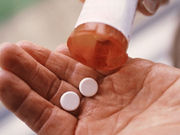Improvements in intramyocellular lipid content, skeletal muscle high-energy phosphate metabolism
FRIDAY, Dec. 16, 2016 (HealthDay News) — For adults with metabolic syndrome (MetS), pioglitazone treatment improves whole-body aerobic capacity, according to a study published online Dec. 12 in the Journal of Diabetes Investigation.
Takashi Yokota, M.D., Ph.D., from the Hokkaido University Graduate School of Medicine in Sapporo, Japan, and colleagues examined the effects of pioglitazone treatment on whole-body aerobic capacity and skeletal muscle energy metabolism in 14 male patients with MetS. Patients received oral 15 mg/day pioglitazone for four months. Exercise testing with a bicycle ergometer was performed before and after pioglitazone treatment to assess whole-body aerobic capacity.
The researchers found that although daily physical activity was comparable before and after treatment, pioglitazone significantly increased peak oxygen uptake and anaerobic threshold (AT) (both P < 0.05). After pioglitazone treatment there was a 26 percent reduction in intramyocellular lipid (IMCL) content, indicating an improvement in skeletal muscle fatty acid metabolism. There was also a 13 percent decrease in muscle phosphocreatine loss during exercise, indicating an improvement in skeletal muscle high-energy phosphate metabolism. There was a close correlation for the increase in AT with the decrease in IMCL content after treatment with pioglitazone.
“Pioglitazone significantly improved the MetS patients’ whole-body aerobic capacity and skeletal muscle energy metabolism,” the authors write. “The beneficial effect of pioglitazone on whole-body aerobic capacity might be at least in part via improved fatty acid metabolism in the skeletal muscle.”
Full Text (subscription or payment may be required)
Copyright © 2016 HealthDay. All rights reserved.








